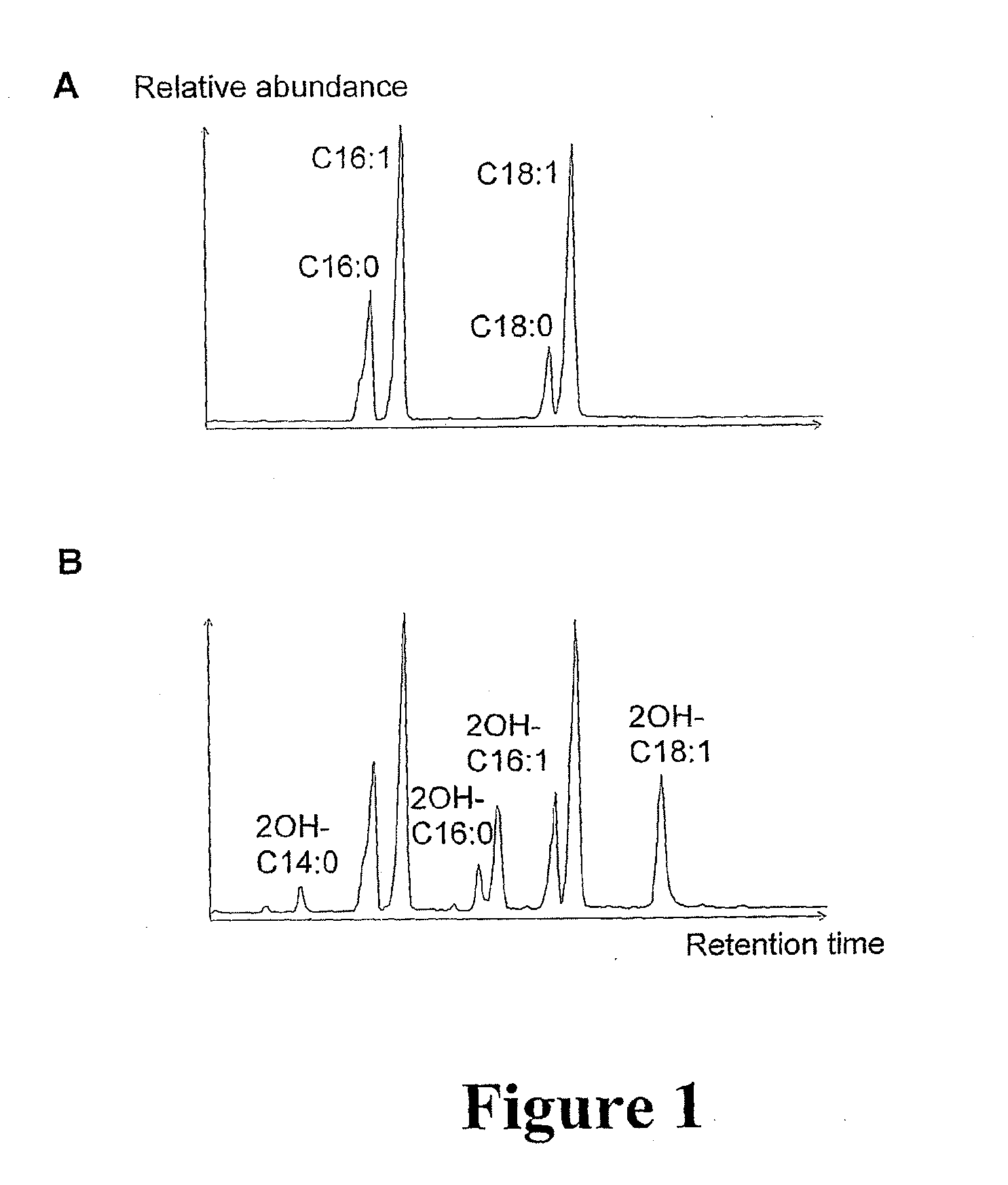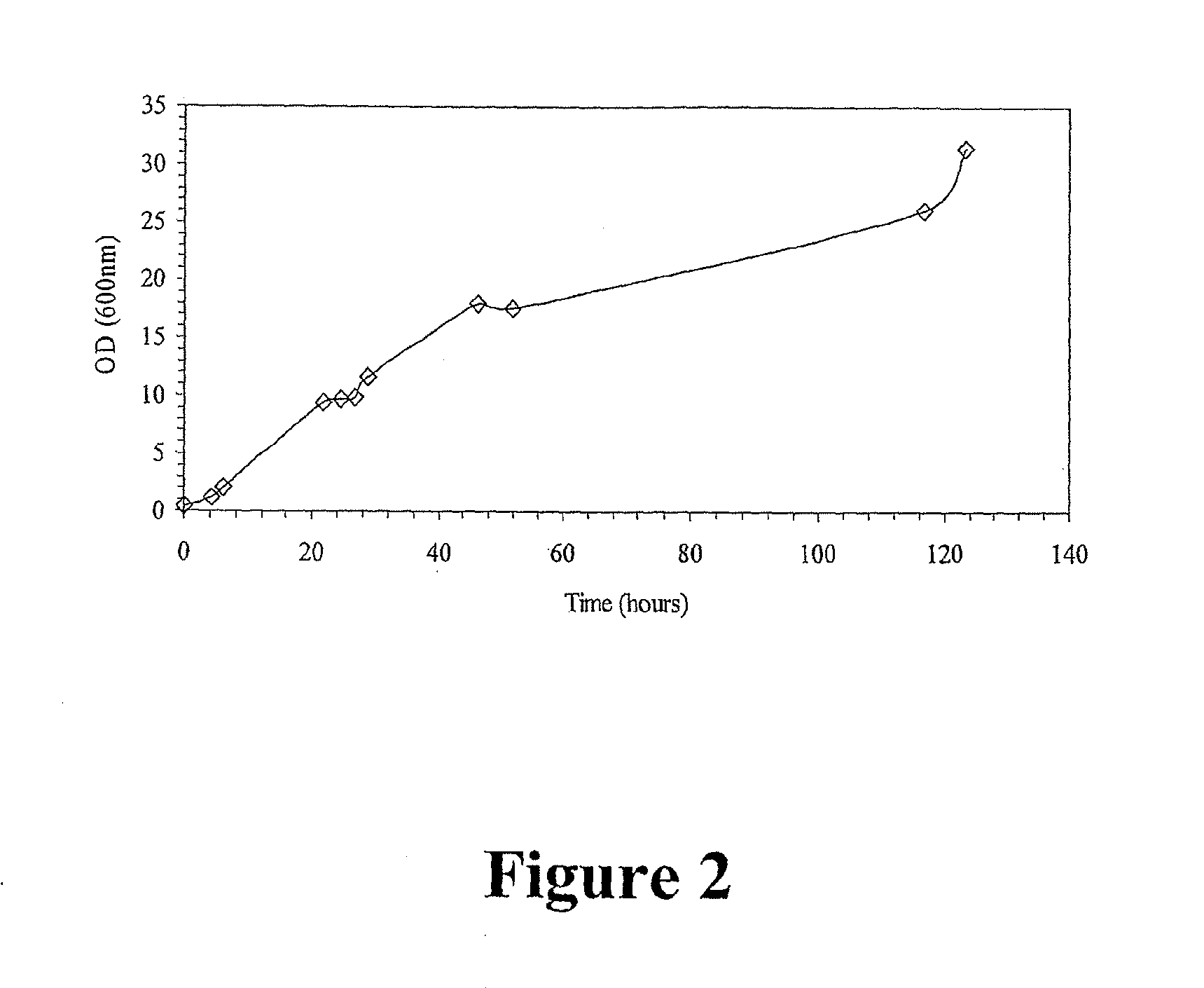Recombinant cells and methods for hydroxylating fatty acids
- Summary
- Abstract
- Description
- Claims
- Application Information
AI Technical Summary
Benefits of technology
Problems solved by technology
Method used
Image
Examples
example 1
Materials and Methods
[0268]Construction of Lemon Thyme cDNA Library
[0269]Total RNA was isolated from developing seeds using Trizol reagent according to the instructions of the supplier. Messenger RNA was purified from total RNA using an Oligotex mRNA kit (Qiagen). First strand cDNA was synthesised from 5 ng mRNA using an oligo-dT primer supplied with the ZAP-cDNA synthesis kit (Stratagene≦Catalogue No. 200400) and reverse transcriptase SuperscriptIII (Invitrogen). Double stranded cDNA was ligated to EcoRI / XhoI adaptors and from this a library was constructed using the ZAP-cDNA synthesis kit according to the suppliers' instructions.
Yeast Culturing and Feeding with Precursor Fatty Acids
[0270]Plasmids were introduced into yeast by a standard heat shock method and transformants selected on yeast synthetic drop out (SD) medium plates containing 2% glucose. Experimental cultures were inoculated the yeast cells carrying different plasmids in SD medium containing 2% glucose, 1% NP-40, to an...
example 2
Isolation of Arabidopsis thaliana FAH Genes and Expression in Yeast Cells
[0277]In an attempt to identify plant or fungal genes which might be candidates for Δ2-hydroxylases active on fatty acids, particularly for phospholipid linked fatty acids, the inventors considered known fatty acid hydroxylase genes from other organisms. The yeast protein FAH1p encoded by the Scs7 gene catalyses the Δ2-hydroxylation (also known as 2-hydroxylation or a-hydroxylation) of sphingolipid-associated very long chain fatty acids. These very long chain fatty acids mostly have acyl chains of 26 carbons (C26). An Arabidopsis homologue of FAH1p designated AtFAH1 (also denoted as ArathFAH1 herein), encoded by the At2g34770 gene, has been shown to complement an scs7 mutation in yeast (Mitchell and Martin, 1997) and presumably catalyses the same reaction.
[0278]When the Arabidopsis genome was queried for genes encoding proteins with homology to AtFAH1, surprisingly a second gene (At4g20870) was noticed, encodin...
example 3
Identification and Characterisation of FAH2 Gene Family
[0283]On the basis of the data in Example 2, the inventors considered whether other plant or fungal enzymes catalyzing the Δ2-hydroxylation of C18 fatty acids might be homologous to the archetypal yeast and Arabidopsis proteins. The plant EST database was searched with the archetypal yeast and Arabidopsis FAH1 sequences using both amino acid and nucleotide sequences, and then searched iteratively using the homologous sequences. More than fifty plants sequences were identified which were, or encoded proteins which were, homologous to the yeast FAH1p and Arabidopsis FAH1. These were represented by partial length EST sequences which did not encode full length proteins. However, contigs covering entire coding sequences (some examples shown as SEQ ID NOs: 14 to 24) were assembled for individual plants species by identifying overlapping ESTs, and the contigs translated into amino acid sequences (some examples shown as SEQ ID NOs: 2 to...
PUM
| Property | Measurement | Unit |
|---|---|---|
| Fraction | aaaaa | aaaaa |
| Fraction | aaaaa | aaaaa |
| Fraction | aaaaa | aaaaa |
Abstract
Description
Claims
Application Information
 Login to View More
Login to View More - R&D
- Intellectual Property
- Life Sciences
- Materials
- Tech Scout
- Unparalleled Data Quality
- Higher Quality Content
- 60% Fewer Hallucinations
Browse by: Latest US Patents, China's latest patents, Technical Efficacy Thesaurus, Application Domain, Technology Topic, Popular Technical Reports.
© 2025 PatSnap. All rights reserved.Legal|Privacy policy|Modern Slavery Act Transparency Statement|Sitemap|About US| Contact US: help@patsnap.com



